I am writing this on a train traveling from Prague to Vienna. The trip is very comfortable, the day is sunny, and the Czech countryside unfolds all around us. However, the wifi service is kaput and so I will probably upload this bit of Monday inspiration closer to Tuesday morning. I hope you have been able to hang on, uninspired.
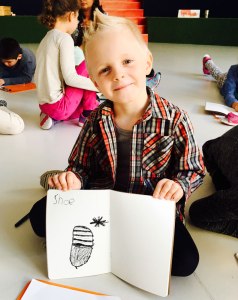 Kids: I’ve spent the past week in Prague, working with students from kindergarten to twelfth grade, and their energy and creativity has inspired me deeply. I don’t pretend to be an art teacher when I visit schools. Kids, especially 2nd to 4th graders are so enthusiastic about drawing and they have so many interesting ways of tackling drawing from observation. I show them a bunch of my own sketchbook pages for inspiration, give them some minimal direction, and then stand back.
Kids: I’ve spent the past week in Prague, working with students from kindergarten to twelfth grade, and their energy and creativity has inspired me deeply. I don’t pretend to be an art teacher when I visit schools. Kids, especially 2nd to 4th graders are so enthusiastic about drawing and they have so many interesting ways of tackling drawing from observation. I show them a bunch of my own sketchbook pages for inspiration, give them some minimal direction, and then stand back.
I drew with several hundred kids over the week and I think we were all surprised at what they made. Kids are perfectly willing to draw from reality, even kindergartners. They are capable of noticing enormous detail and of the discipline to sit quietly with pen in hand for up to an hour. It’s pretty amazing to see a room full of 7 year-olds staring at their shoes with wrapt attention.
Their creative energy and fearlessness inspired their teachers and parents too. I heard lots of stories of little kids insisting their entire families draw together, of unused sketchbooks being taken down and filled up, of ancient fears being addressed and overcome. Having an entire community start to express their creativity together is powerful and infectious.
If you haven’t drawn with a kid recently, give it a go.
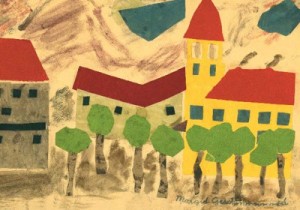 Terezin: In 1941, the Nazis set ups a transit concentration about 30 miles from Prague. Terezin was a propaganda project, a “model ghetto,” used to con the Red Cross into believing all was well, that the Jews enjoyed self-government and idyllic conditions. The reality was different — a way-station en route to the death camps that processed 140,000 Jews from all over Europe, many of whom were children.
Terezin: In 1941, the Nazis set ups a transit concentration about 30 miles from Prague. Terezin was a propaganda project, a “model ghetto,” used to con the Red Cross into believing all was well, that the Jews enjoyed self-government and idyllic conditions. The reality was different — a way-station en route to the death camps that processed 140,000 Jews from all over Europe, many of whom were children.
The Jewish self-government tried to create an alternate reality for the children, shielding them from awareness of their fate, and turned several of the dormitories into recreation centers. The Nazis forbade organized education of Jews, but the inmate were able to offer drawing lessons which they believed were key to knowledge and communication skills.
Rather than be drilled with formal drafting skills, the children were encouraged to express themselves, their memories, fantasies, and fears. They explored morality, the battle between good and evil, folk tales and biblical stories that could serve as moral examples. They documented their personal histories, their experiences in the camp, their visions of the future. Drawing was their only therapeutic outlet, the only way to cope with the unimaginable situation they and their families were in.
Friedl Dicker-Brandeis, a Viennese painter and inmate of the camp, became the primary driver behind this art program. She later volunteered to go to Auschwitz to join her husband, first hiding 4500 drawings made by the children of Terezin. She and most of the children did not survive the war, however their art lives on in the Jewish Museum in Prague. It’s a fairly awful museum, poorly presented and documented, but the children’s art outshines this dismal presentation.
For me, seeing this work, after a week spent with healthy, happy, free children, was a transformative experience. This was the most powerful example I’ve seen of the power of art to shine light on the darkest corners, to provide meaning, education, and hope, despite calamity.
Art is not a luxury, a ‘nice to have’ — it’s central to what it means to be human. If your children or grandchildren are not getting enough encouragement to make art in school, find a way to keep their imaginations alive, not just on the screen of an iPad but with a pen, a box of crayons and a sketchbook of their own.
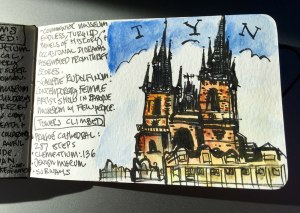 Praha: Prague was the only major city in Europe not to be bombed during WWII. So, thankfully, a thousand years of wonderful architecture has been preserved there for me (and you) to draw. I didn’t have nearly enough time to draw all I would have liked but I did get a chance to record some of the amazing cathedrals, the castle, and the rooftops sprung fresh from Tim Burton’s imagination.
Praha: Prague was the only major city in Europe not to be bombed during WWII. So, thankfully, a thousand years of wonderful architecture has been preserved there for me (and you) to draw. I didn’t have nearly enough time to draw all I would have liked but I did get a chance to record some of the amazing cathedrals, the castle, and the rooftops sprung fresh from Tim Burton’s imagination.
If you are any sort of urban sketcher, I urge you and your pen to hop on a flight to Prague, especially when the weather is nice (as it was, unseasonably so, much of the time I was there). The views are great and the beer is cheap.
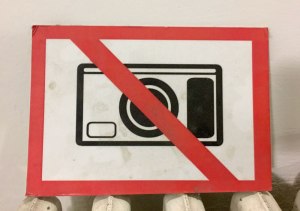 Flaesh: Most of the museums of Prague were frankly a disappointment. They featured huge slabs of dry explanatory text in microscopic fonts, undistinguished objects mixed in with very occasional treasures, and staff that were trained in the Moscow DMV sometimes in the early 1970s.
Flaesh: Most of the museums of Prague were frankly a disappointment. They featured huge slabs of dry explanatory text in microscopic fonts, undistinguished objects mixed in with very occasional treasures, and staff that were trained in the Moscow DMV sometimes in the early 1970s.
However in the Galerie Rudolfinum, we saw a wonderful show of a half dozen contemporary women artists, including favorites like Marlene Dumas, Kiki Smith and Lousie Bourgeois.
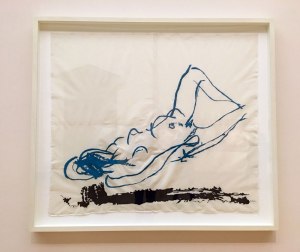 Two artists that are fairly new to me were Tracey Emin and Berlinde De Bruyckere. Emin’s work is strongly autobiographical, confessional and sexual. She’s an extraordinary craftsman — there are pieces made of neon, several of the drawings were stitched into the canvas, others that seemed to be watercolors were actually woven tapestries.
Two artists that are fairly new to me were Tracey Emin and Berlinde De Bruyckere. Emin’s work is strongly autobiographical, confessional and sexual. She’s an extraordinary craftsman — there are pieces made of neon, several of the drawings were stitched into the canvas, others that seemed to be watercolors were actually woven tapestries.
 De Bruyckere makes work that is monumental and grotesque. My favorite is what seemed to be a collapsed, flayed horse stuffed into a large wooden cabinet with an old Dutch label, evoking the recurring butchery of war, colonialism, suffering, loneliness and death. The work is unapologetic and blunt. Seeing it in this spacious, baroque museum, so unexplained and stark, moved me almost as much as that of the children of Terezin.
De Bruyckere makes work that is monumental and grotesque. My favorite is what seemed to be a collapsed, flayed horse stuffed into a large wooden cabinet with an old Dutch label, evoking the recurring butchery of war, colonialism, suffering, loneliness and death. The work is unapologetic and blunt. Seeing it in this spacious, baroque museum, so unexplained and stark, moved me almost as much as that of the children of Terezin.
 My inspiration this week is admittedly dark. Maybe it’s being in this Medieval city, surrounded by magnificent but unattended churches, the specters of WWII and the Iron Curtain still so present. Maybe it’s the autumn skies, the collapsing Jewish cemetery, an excess of Pilsner Urquell, the profusion of consonants in the Czech language. I am having a wonderful and inspired time — but my palette is indigo and umber.
My inspiration this week is admittedly dark. Maybe it’s being in this Medieval city, surrounded by magnificent but unattended churches, the specters of WWII and the Iron Curtain still so present. Maybe it’s the autumn skies, the collapsing Jewish cemetery, an excess of Pilsner Urquell, the profusion of consonants in the Czech language. I am having a wonderful and inspired time — but my palette is indigo and umber.


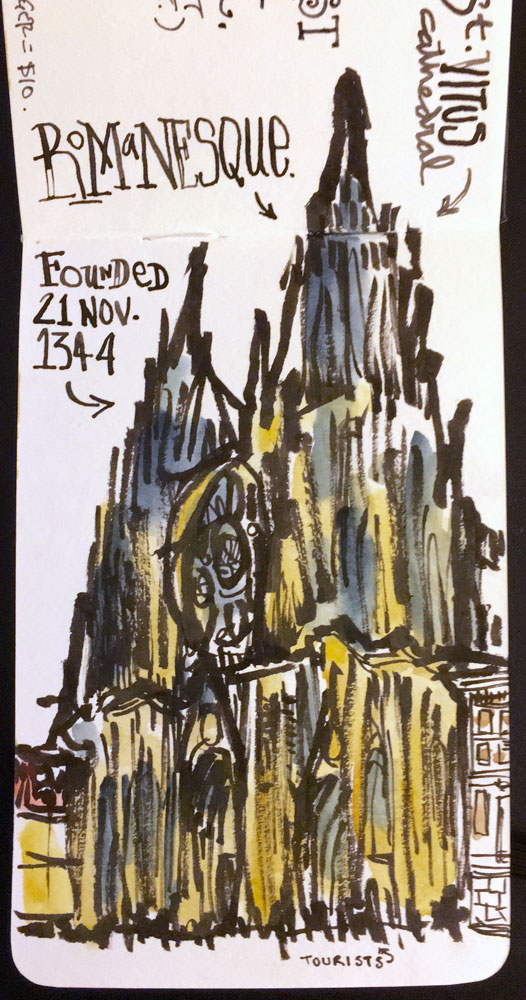
I am deeply moved by your sharing from this trip.
LikeLike
Indigo and umber!
LikeLike
Quite the spectrum of emotion of emotion, art and life. And the history so important for us to remember – thank you for sharing.
LikeLike
I recently visited my 4 year old niece with a tiny sketchbook for her and neon beefy sized colored pencils! I would draw something she asked for in ink and she would color it in. I was told that after I left, she kept filling her little sketchbook!
LikeLiked by 2 people
Wow, Danny. Thanks! Deeply moving. We lived in Germany for four years, right after the wall came down. We traveled alot across Europe, to Prague and Vienna, so I can imagine your route. Unfortunately I wasn’t drawing at the time. We visited a concentration camp and I will never forget it. We need to hear these stories. If I were a filmmaker, I would produce a movie about the very brave & very heroic Friedl Dicker-Brandeis.
LikeLiked by 1 person
Thank you for sharing this experience. It allows me to travel and experience this art by proxy which I would never find in the travel guides.
Also enjoyed your “filling the well” blog post.` My animated cinema suggestion is “The Triplets of Belleville”
LikeLike
In light of the terrorist attacks onFriday your encouragement for children of all ages to draw is a gift.You remind us that art can be a light in the darkness thank you
LikeLike
[…] Gregory visited Prague and Vienna recently and shared some of his thoughts during that trip, and what had been inspiring […]
LikeLike
Thank you Danny for the great article! Love to read how people experience Europe, what happened in history and what is going on here. Just returned from Amsterdam ( Van Gogh/ Munch exhibition) and lucky i did not book for Paris!
Berlin de Bruyckere is in my eyes a great artist, specially her works with horses, it really takes you by the throat!
Very interesting how many young people you meet all over the world, everyone happy about creating and positive energy!
LikeLike